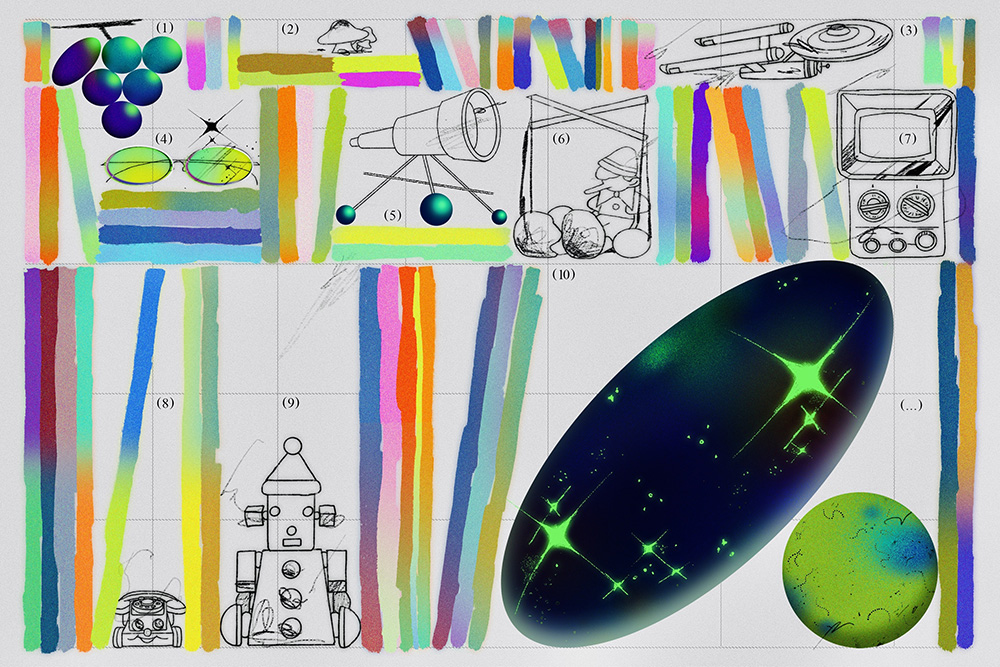
Artwork by Sharon Park at COLLINS.
A library—5,572 volumes and always expanding—is the heart and soul of COLLINS’ practice. Nested among the books of the floor-to-ceiling shelves that line the walls of the front room of our Brooklyn office are African dolls, a Star Trek starship, Pinocchio puppets, robots, toys, and vintage signs. A nine-foot tall, blue Muppet—Thog—stands guard just outside in a hallway. (Thog followed us home one day while we were working on the Jim Henson Exhibition at the Museum of the Moving Image.) Everything here—book, toy, poster, sculpture, model—has a story to tell.
Our work begins in the library because there are few, if any, problems that are truly novel. We look to history, science, fiction, news, math, mythology, music, plays, art, economics, finance, psychology, cosmology, archeology, education, children’s books—everything we can explore to understand better what others before us have done when confronted with similar challenges. We try on strategies from different eras and disciplines. We test out combinations. In the library, we can find precedents for each of the many daunting problems that face us today. What is different is facing so many challenges all at once. We think about implications—and opportunities—writ large. We think about implications for our clients. (We think about implications for their clients.) We keep an eye on the news. We return to the library every chance we get. We look for patterns and synergies. We pay attention. To everything.
And we always have our radar up for the adjacent possible. This wonderful turn of phrase was originally used by biologist and complexity theorist Stuart Kauffman to describe the collisions of Earth’s starter molecules that eventually led to the creation of all the molecules required for the emergence of life.
In his book, How We Got to Now, Steven Johnson trades out molecules for innovation. Everything around us—from toasters to space ships—not only has a long, meandering backstory, but also provides backstory for the next round of inventions. Gutenberg’s printing press, for example, was inspired by presses for making wine in his hometown. All those then-newly printed books boosted an increased demand for eyeglasses which, in turn, led to innovations in lens-making, which led to better lenses for microscopes and telescopes. Without wine, would we know about microbiomes? Or about stars born 6,500 light years away in the vast cosmic dust clouds of the Pillars of Creation?
So we kick the tires on every cutting edge technology. We play, experiment and wrestle with AI, blockchain, and whatever comes next. We ask, “What will we be able to do tomorrow that we cannot do today?”
Design is thinking.
Transformation
The companies we admire...
The companies who have gone the distance...
The companies with a future...
Transform.
Constantly.
These are the companies run toward the adjacent possible, that embrace transformation as a dynamic constant, never as an endpoint.
A fearless curiosity to open doors that lead to more doors and is at the heart of Steve Jobs’ challenge to “think different.” Jobs’ understood exponential, alchemical—transformational— power of combinations: a smart phone coupled with an app store; a crew of troubleshooters at a “Genius Bar” doubling as brand evangelists.
Jobs was also a natural systems thinker adept at integrative design, an engineering methodology to develop solutions that often push the constraints of conventional wisdom.
There are three parts to the process:
1. Start with outcomes: What are the desired results?
2. Draw from an expanding, cross-pollinating assemblage of ideas, technologies and business models. Integrative design is dynamic and intrinsically transformative, offering a path for continued improvement.
3. Make sure that every part of a system performs at least two different, meaningful functions.
Apple, now valued at $3 trillion, is the most successful company in history. Its recent move into banking services is quite a leap from the personal computers that first put Apple on the map. Yet when understood as a progression of systemic, integrated innovation, it makes sense. And while early reviews are mixed for the pricey “Vision Pro” headset, Apple’s first foray into “spacial computing,” the company’s remarkable track record and deep, deep pockets buy it plenty of time to keep trying.
Resilient Futures
As designers, we have a direct line to the people who run the companies that run the world. We are hired to think creatively, expansively, imaginatively, and incisively. We are invited to the table at a point when change isn’t only possible, but also desired. Our ability to help businesses and organizations understand and see themselves in new ways can be transformative, triggering cascades of collateral goodness where solving for x leads to better answers for y and z, too.
In a little over 200 years—only ten generations—the human population has exploded from from one billion to eight billion. During that brief time, the planet’s natural bounty has declined dramatically and the climate has been knocked completely off balance.
It is time to live up to our aspirational species moniker, Homo Sapiens (wise human). Or, better yet, aim higher: Homo Imaginativi (imaginative human). To do different (and better) requires imagination and creativity. This is where design and designers can make a difference.
Every business has the potential for a resilient future. The ones that understand how a transformative mindset can unlock the “adjacent possible” are already well on their way. Our job, our vision, and our purpose is to work with leaders who understand that what happens now matters. Because what happens next depends on it.
Read Resilient Futures, part one The Challenge.
